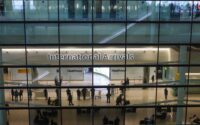Scared of flying after recent plane accidents? Hereâs how experts say you can stay calm
Is yours soaring?
Flight anxiety has taken off this year after a series of deadly collisions and scary incidents have occurred in the last few weeks.
More planes are hitting the air than ever before, but the industry is lagging with filling shifts for airline staff and air traffic controllers. That along with several investigations into airplane malfunctions has some travelers worried about flying.
A study published last year found that a staggering 49% of Gen Z, 39% of millennials, 38% of Gen X and 40% of baby boomers are afraid to take to the skies.
And it’s safe to assume those numbers have only increased in recent months.
A study released Wednesday found that 64% of adults think flying is “very or somewhat safe,” compared to 71% in 2024.
However, it should be noted that the majority of adults still believe it’s safe to board a plane.
“Anxiety about flying can range from mild to severe,” licensed therapist Jenny Matthews, owner of Minnesota-based State of Mind Therapy, previously told Travel + Leisure.
“If someone has mild anxiety symptoms, they may feel on edge about their flight or experience nausea, but they continue to travel by plane anyway. Others with more severe flight anxiety [might experience] significant anxiety symptoms like panic attacks, difficulty breathing, and intense fear, which may lead them to avoid flying completely.”
To help passengers check their anxiety at the gate, here are some pro tips to help you have a calm flight.
Find the facts
Markus Mainka – stock.adobe.com
Traveling thousands of feet in the air is the safest form of transportation, experts say, including the National Safety Council.
Commercial pilots must have an airline transport pilot certification, the highest possible aviation credential, Thomas Anthony, director of the USC Aviation Safety and Security Program, recently told the Los Angeles Times.
And all commercial aircraft are routinely inspected and maintained by the Federal Aviation Administration and directed to fly within a regulated air traffic control system.
However, some seats can be safer than others.
Statistically, the middle seats in the back of the aircraft are the safest, with just a 28% fatality rate compared to aisle seats in the middle of the cabin, which had a rate of 44%, according to a Time analysis of 35 years of FAA data.
Act it out
“The odds of something happening don’t matter as much to the anxious brain,” Andrea Bonior, a teaching professor in Georgetown University’s department of psychology, told the LA Times.
“The anxious brain is drawn in by the horrific stakes of something.”
If knowing the facts doesn’t soothe you, one way to manage your anxious brain is to visualize what’s making you nervous.
lightpoet – stock.adobe.com
Play out the situations that worry you in your head and be realistic about how you would likely respond.
If you know you might freak out, board the plane knowing that and run through what you would need to do to stay safe and calm to ease your anxiety and not add more stress by being disappointed in your reaction, Bonior advised.
Once you’ve gone through the worst-case scenarios, be ready with whatever you might need to get through a possible anxiety-inducing situation, whether it be a fidget spinner or downloaded meditation.
Acknowledge your emotions
Labeling emotions lowered anxiety for people with flight anxiety, according to a study published in PLOS One.
Acknowledge your feelings and put them into words; that will help you to face and work past them.
And don’t just keep them to yourself. Interacting with others around you can be a nice distraction, and sharing how you feel can relieve some of the built-up anxiety as well.
Relax your body
If managing your mind isn’t working, try relaxing your body.
Focus on how you’re feeling physically and unclench your muscles. Take deep breaths and scan your body, starting with the muscles in your face, making sure to release any tension from your head down to your toes.
Once you’ve melted into your seat, continue with some breathing exercises to keep from clenching back up.
One effective method is tactical breathing — it’s used by service members, first responders and law enforcement personnel to steady nerves and stay sharp in high-stress situations.
Practice this technique:
- Close your eyes and inhale slowly through your nose, counting 1-2-3-4, visualizing each number as you breathe in.
- Hold your breath for a count of 1-2-3-4.
- Slowly exhale through your mouth to the same count: 1-2-3-4.
- Repeat the cycle three to five times.
Distract yourself
Once you’ve done your best to calm yourself and settle into your seat, try to enjoy the ride.
Ryanair flight attendant Rhia Kerr previously shared some tips to help anxious passengers get through a bout of turbulence — and they are likely to help beyond just getting through a bumpy ride.
She suggests “getting noise-canceling headphones, as certain noises that the aircraft makes can be unsettling.”
Kerr also recommends that a nervous flier write a list of things to do or exciting moments that will happen once he or she gets off the plane, which can act as a distraction.
Turning on an in-flight movie, reading a few chapters of a book or listening to music can also help to take your mind off your worries and pass the time.


